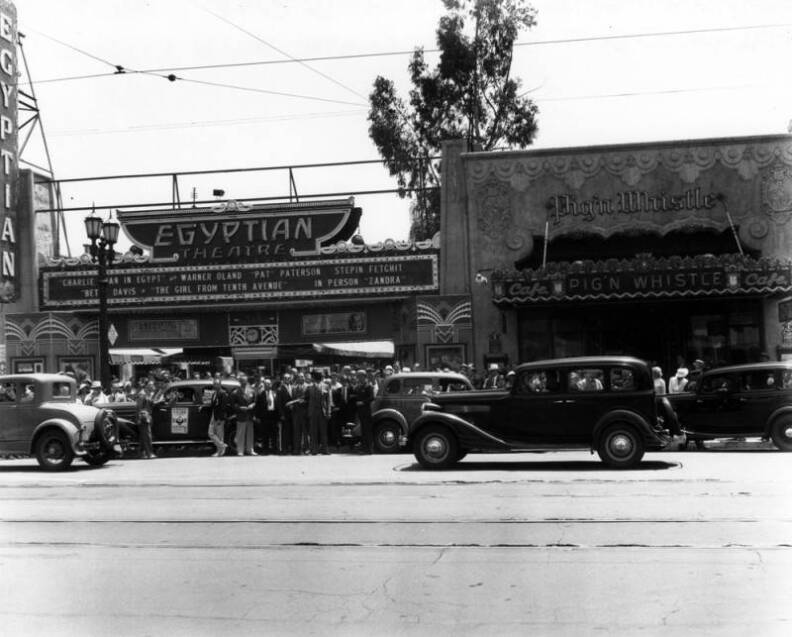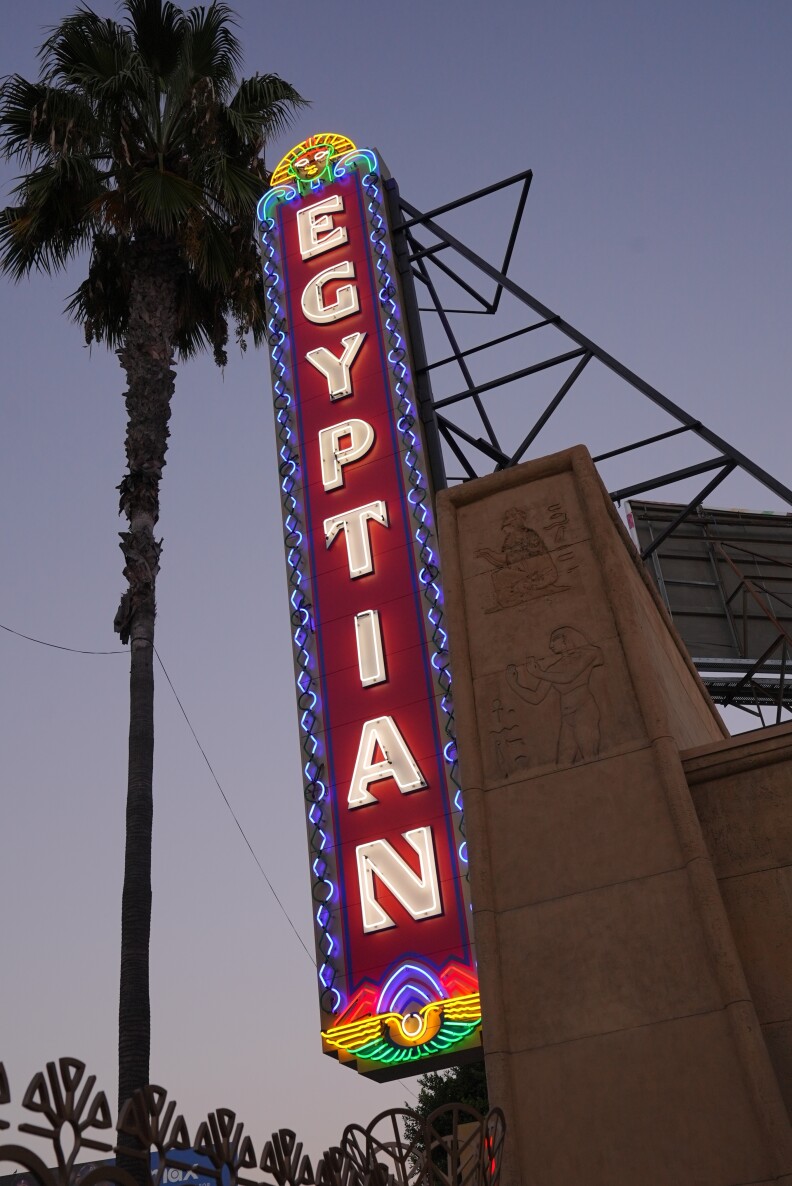The historic Egyptian theater in Hollywood officially reopened its doors last weekend and people were eager to see inside the 101-year-old movie palace after a two-year closure and extensive renovation.
Last Saturday night, the theater was screening a vintage film, Jacques Tati’s Playtime on 70mm.
One moviegoer by the name of Yasmin was in her seat eagerly waiting for the show to start.
“L. A. has so many unique theaters that are, you know, outside AMC and also we're so excited to see something here and know that they have a slate of movies to show,” she said.
“I was very excited for Playtime,” her boyfriend Michael chimed in.
It was their first time at the Egyptian.
-
Nonprofit's launching fundraiser to keep it afloat
-
USC study documents what residents want from trees
-
What candidates can — and can't — say they do
A controversial sale
Film fans and L.A. history buffs everywhere have been eyeing this reopening — some with excitement, others with trepidation. After all, it’s one of the city’s grandest movie houses, built when Hollywood was just a burgeoning industry.

The theater hosted the film premiere of Robin Hood with Douglas Fairbanks in 1922 as well as films from Charlie Chaplin and Cecil B. DeMille throughout its first decade. In more modern times, it was films like Return of the Jedi in the 1980s that drew crowds to the Egyptian.
The theater changed hands a couple of times over the decades, but its most recent sale stirred up some controversy. In 2020, American Cinematheque sold it to the streaming service Netflix for a publicly undisclosed sum, and some critics voiced concerns about “for-profit” interests taking a stake.
American Cinematheque is a group that’s been programming theaters across L.A. with diverse repertory films since the 1980s and it has a pretty good rep among movie fans. It operated the Egyptian for more than 20 years before selling it to Netflix.
It bought the theater in 1996 from the L.A. Community Redevelopment Agency for a dollar after it was damaged in the Northridge Earthquake. The Cinematheque restored it and reopened the theater in 1998, but the Egyptian eventually became a financial struggle to run.
Enter Netflix, a controversial 'hero'
“To make this deal with Netflix and have it come back stronger than ever,” said Grant Moninger, the artistic director at the American Cinematheque, “it is a real blessing.”
Even during opening weekend, some moviegoers shared skepticism about the new owner.
“We hope Netflix doesn't sanitize and make this mainstream cinema central,” said Ryan McGurk while standing in line for popcorn. “This is the home of art house.”
But Moninger argues that regardless of who bought it, the theater has been saved and that’s a win.
“We were unsure if we were ever going to come back. It would have been a huge financial burden,” he said. The Egyptian “could have been a nightclub.”

Theater historian Ross Melnick agrees: “Anyone who will help reopen and restore a movie palace is gonna get hero status from me.”
Melnick teaches film and media studies at the University of California at Santa Barbara.
Film fans can take heart in this fact: The programming slate at the Egyptian will offer more than Netflix films. As part of the deal with the streaming service, the American Cinematheque has a 100-year-lease to show films every weekend. Classic films like Aliens and Laurence of Arabia will be projected on 70mm, as well as some smaller art house movies.
The Egyptian 'consecrated the launch' of Hollywood
Real estate developer and recognized showman Sidney Patrick Grauman opened the Egyptian Theater in 1922. The neighboring Chinese Theater is also Grauman’s creation.
As historian Ross Melnick explained, Grauman had this “idea that if you could build a place for film exhibition and film production, you could essentially create almost a whole new city…for tourists, entertainment and attractions.”

“I think one thing to remember is that Los Angeles, even though now, of course, it's the global capital of moviegoing and moviemaking, was not that in the early 1920s — it was New York,” Melnick said. “Hollywood, on the other hand, was… kind of a real estate development project.”
The 1920s were a boom time for L.A. The population was growing, surpassing San Francisco’s for the first time, and moneyed interests had traveled west to capitalize on the already powerful oil industry. Officials had greatness on their minds. They wanted a city to rival that of New York and Chicago. In 1923, the Memorial Coliseum went up. So did the Biltmore Hotel and the Hollywood Sign. The art deco marvel that is L.A.’s Central Library downtown followed a few years later.
The early 20s was still the silent film era, but the movie industry was picking up steam here. Stars like Douglas Fairbanks and Mary Pickford had moved to L.A. and a lot of movie making was happening on the West Coast. One of those film “attractions” that Grauman spoke of became the Egyptian Theater.
“The opening of the Egyptian essentially consecrated the launch of Hollywood as an institution,” Melnick said.
Capitalizing on Egyptomania
There was already a Western fascination with Egypt, notes Melnick, as archeologists uncovered its many treasures during the early 20th century. King Tut’s tomb was discovered later in 1922 — a month after the Egyptian Theater opened.
This “Egyptian Revival” architecture inspired the theater’s design with its courtyard, hieroglyphic themed murals, and the winged scarab atop the theater’s proscenium arch.

“It was all about the architecture of fantasy and the architecture of fantasy is no more exciting than being whisked away, if you will, 'Thief of Baghdad' style to Egypt by going into a movie theater,” Melnick said. “I think that's just something to think about. What is a movie palace in this period? It's a way to get off the street and be essentially taken into a palace of fantasy.”
And, according to Melnick, the Egyptian was heavily promoted as a place to do just that. There were movie ticket offices set up in Hollywood and downtown L.A. but also Long Beach, San Diego and Santa Barbara. There were organized bus trips that would take people to Hollywood, Musso & Frank and then the theater.
America was still coming out of World War I and the Spanish Flu pandemic. People were craving spaces to gather as the roaring 20s picked up and the Egyptian Theater created a sense of accessible opulence for people, said Melnick. It was beautiful, exotic and transportive.
“Going into a movie palace with ushers gave you that sensation… to live like a king and queen for the price of a ticket,” Melnick said.
And, said American Cinemateque’s Grant Moninger, that feeling of opulence is back. The recent renovations have restored the architecture, including the placement of the projection booth inside the theater, “back closer to 1922 than it's ever been,” he added.
So see a bit of history for yourself, catch a movie on film, and sit in what many moviegoers said last weekend are the most comfortable movie theater seats in the city.







